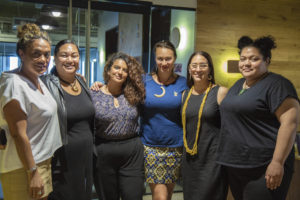Interview with Directors of “Vai”
Written by: Christopher Llewellyn Reed | August 27th, 2019
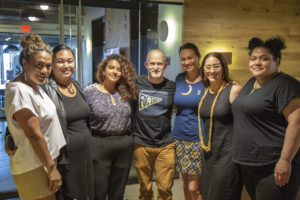
At SXSW 2019, I interviewed the directors of 6 of the 8 episodes that comprise the anthology film Vai (which I reviewed for Hammer to Nail): ‘Ofa-Ki-Levuka Guttenbeil-Likiliki, Matasila Freshwater, Amberley Jo Aumua, Mīria George, Marina Alofagia McCartney and Dianna Fuemana (in order of their films within the film, numbers 2 through 7).The movie follows the life of one woman, from age 7 to 80 – or of multiple women experiencing similar trajectories over time – in the South Pacific, whose name, Vai, irrespective of linguistic variants by island, means “water.” We start in Fiji and end on Aotearoa, with many stops in between. Beautiful and profound, the film showcases the talents of a multiplicity of women both behind and in front of the camera. Here is a condensed digest of our conversation, edited for length and clarity.
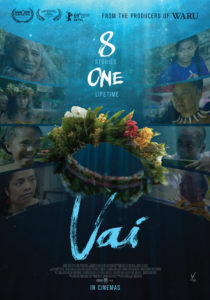
Christopher Llewellyn Reed: How did producers Kerry Warkia and Kiel McNaughton, who were behind Waru, pitch this new film to you?
Mīria George: Kia orana! [Hello!] Kerry and Kiel shoulder-tapped around 70 Pacific filmmakers to submit an idea that focused on women and women’s relationship to the water. So, we all submitted and then their process boiled us down to 9 to be a part of this feature-film project. We knew of Waru and we knew that we would be working within the same framework: 10 minutes to tell a story and 8 works in total.
CLR: So, was it always part of the challenge that these stories needed to be done, if possible, in a continuous take, and how did they pitch that to you?
Marina Alofagia McCartney: That was an existing framework, because they also used that framework of the continuous take for each vignette in Waru, and they just told us, “This is how it’s going to be.” And I think that without that framework, we probably wouldn’t have captured the film as quickly as we did, because the collective creative process started in May of 2018, and we delivered a completed feature film in December.
CLR: Only one of the 8 films, that I could say, had an obvious cut, which is the final episode, which has a very abrupt cut, which actually serves that story. There were a couple of other places in the other films where I thought that maybe, though it looked like a continuous take, it actually wasn’t, but was cheated very well. For example, in the third film, in the Solomon Islands, where she’s 16 and jumps into the water … was that a cheated cut?
Matasila Freshwater: Oooh, should I give away my movie-magic secrets? (laughs)
CLR: It doesn’t really matter, because it looks like a continuous take.
MF: Well great! I’m glad. But no, it wasn’t a continuous take. (laughs) We were actually rained out on the day we wanted to get that shot. So, we took all the drama in one day, and then the day we were supposed to fly out from the Solomon Islands, I said, “I need that underwater shot. I need that hero image.” So the producers were like, “Right! We’re doing it!” So, on the morning when we’re supposed to catch a flight, we had an early call time, we got out there and I got to watch the sun rise over a World War II wreck and review shots, which was really amazing.
CLR: Well, it’s really well done. The other piece where I thought I saw a possible cut is in the Cook Islands one, where she’s 30, riding the motorbike and then she runs into the field through whatever those tall plants were, and I thought …
MG: … that’s a little bit of movie magic, as well (laughs).
CLR: It was clever. You know, anytime you see those kinds of wipes across the frame, you think, “I wonder if that was a cut.”
MG: Those banana leaves, they’re magical! (laughs)
CLR: I really liked, as well, the follow on the motorbike. It was really well done.
MG: And if you’ve been to Rarotonga, scooters, or bikes, are a big part of island life there. It’s a very small island and a lot of people transport multiple family members on bikes. Right from the first five days where we were storylining and building our feature film, I knew I wanted to have a bike in my story.
CLR: Right, because it fit the location.
MG: Yeah! And also, we’re telling the story of a woman’s journey through life, and you literally see that, whether she’s on a boat in the water or on a beat-up old Toyota 50cc bike. (laughs)
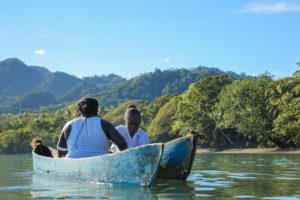
CLR: How did you cast? I’d like to hear from all of you how you cast your individual films.
‘Ofa-Ki-Levuka Guttenbeil-Likiliki: So, I was story number two, in Tonga. I cast on Facebook, social media and also radio, and in the first two audition calls, no one turned up. I knew that was going to happen, but I was just following process. And after that didn’t happen, I visited schools around my area and went up to young girls that I knew or had connections to. We have a very small island, and I know everyone; if I don’t know the kids, I know their parents.
And so I just said, “Anyone want to act for a movie?” And they were just like … (makes a bewildered sound) … it’s a concept that’s just way far-fetched for them. They can’t consider themselves as acting on the screen, and I don’t think, to this day, that they actually understand the bigness of what we’ve just done, because we’ve never been able to tell our stories in this way. I managed to get 12 or 13 young girls together, and then I just told them what the story was about and I gave them a couple of lines and said, “Let’s go from there and how would say it?,” in terms of how you would play this character out. So, yeah, that’s how we did it.
CLR: As much as I like your lead girl, her younger brother, Elvisi, is wonderful. That boy is just so perfect for that kind of little brother, dragging his feet.
(everyone laughs)
‘O-K-L G-L: I’m going to shout you lunch after this, because I’m biased … he’s my son! (laughs)
CLR: (laughs) Oh! He was wonderful! Really perfect!
MF: So, my lead actress was Betsy Luitolo. And yeah, it’s incredibly hard to cast on the islands. We don’t have a lot of opportunities over there, and it’s really hard for them to even conceive of doing a feature film on the island. But her sister had gotten her in contact with us, because she saw our Facebook post, and Betsy had written this really beautiful letter to the producers, and from that I got that she was really willing and really brave. And that’s what I needed in my actress. And so, my cousin in the Solomons was helping me on location, and she said, “Oh! I know this girl. I used to teach her!” And I was like, “Great!” And from there it was a really easy process to make contact with the family and embrace them into what we were doing.
CLR: She’s wonderful, too.
MF: She’s amazing. And I’ll tell her that, too. She needs to see it, and to see the audience reaction.
CLR: It’s amazing that you got these non-professional actors and they delivered these terrific performances.
MF: It’s kind of their story, so they can connect.
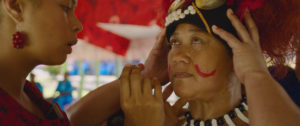
MAM: So, again, I did the Samoan vignette, and it was actually during our writers’ retreat that Dianna, who wrote and directed the Niuean piece, said, “What about Fiona Collins?” And I just went, “Oh my goodness. She would just be amazing.” So she was always the person in my mind. And the reason why I wanted actors with professional experience was because I knew it was going to be the first time I was dealing with a bigger group of women, so I wanted people who knew what they were doing. The Vai in my film has to carry the entire piece, and Fiona just did it, incredibly.
Amberley Jo Aumua: So, I did the “New Zealand-born Samoan” piece …
CLR: Where she’s 21.
AJA: Yes. Where she’s at university.
CLR: And could you explain the title of that film? Where is that piece taking place? It’s called “New Zealand-Born Samoan,” so where is it? On New Zealand, itself?
AJA: It’s on the north island of New Zealand.
CLR: OK, that’s what I thought. It takes place on New Zealand, but she, herself, is ethnically Samoan.
AJA: Yes. So, we worked with a casting director, and what I wanted was someone who wasn’t a trained actress. I put posts out on Facebook, I contacted my community and friends, and my actress came through a friend of mine. When we held auditions, I saw a vulnerability that I really liked, and that’s how she was cast. Her costar was also through a mutual friend.
CLR: The guy who plays her friend? I really liked him.
AJA: Yes. And then, what I found out during rehearsal was that those two actors were actually close friends in real life, so the chemistry between them was easy. As for the other extras, those were mostly my friends that I went to uni with. My casting was a bit late, because I needed to find someone from my community, and she was from my community.
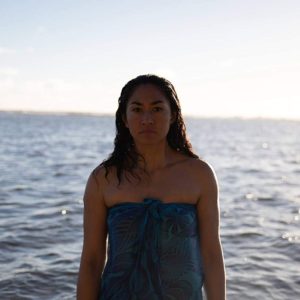
MG: Again, I did the Cook Islands segment. I’m a playwright and so my way of building character is to work around people that I know. When I was writing my vignette, I thought of my cousin, and she was my key focus for those early sketches of the character. We did a casting in Rarotonga, as well as in Auckland. I was based in Rarotonga at the time, and so auditioned maybe 8 or 9 different women. I think what the process in Rarotonga really revealed to me was the abundance of talent that we have in our people. And in the end, my cousin auditioned in Auckland, in New Zealand, and looking over all of the auditions, she had a fierceness …
CLR: Yes, she is very fierce!
MG: Yes! That character needed that! She’s not from an acting background, at all, and so it was her first film role.
CLR: Wow! She’s so committed. I wouldn’t have thought that.
MG: And working with her, we talked a lot about approaching it like a sports tournament, so her first day on set, she turned up with her headphones and music on, getting in to game zone, and she was great. I think she may have caught the acting bug, just a little. (laughs)
Dianna Fuemana: I did the piece on Niue, and I used the opportunity when we were scouting to try and find my cast on Niue through people on the island whom I knew. I put a call out and we got about 5 Vais, but at the time, my screenplay focused on Vai and her husband. And so I had 3 men and 5 women, and it was hard, since I was looking for actors over the age of 60. What I found in my audition process was that the women and the men who were coming forward were brother and sister … (laughs) … so I realized very quickly that I had to kind of re-shift my story, because to try and capture romance and love between a brother and sister was going to be really, really … not the thing to do. And I didn’t want to wreck my island by it, so there were all these issues of jealousy, as well, if I cast one person over another.
So, in the end, we had a call out in Auckland, and we had about 3 women come along, and my Vai was a pretty late audition, so it was really cutting it close. But she came to the audition and she aced it. She had a confidence about her. It’s hard to be a director when you’re working with an older woman, because you don’t want to boss them around, and you don’t want to be too strong and you want to show respect, but I knew that she had something that would allow her to listen and not get upset. (laughs)
CLR: The other thing I really like in your piece is that location you start out in, carved out by the sea or the wind. It makes it look like she’s almost shipwrecked, for a moment. You think, “Where is this story going?,” since she’s all alone, and then the younger woman comes in. I really liked that.
(everyone murmurs assent)
DF: That’s a very special place in Niue. It’s my village of Mutalau. The bible came up through that passage onto our island; Niue was one of the last islands to be colonized. In that regard, the location was really special, but I also knew I wanted to shoot there because, in regard to water and the Pacific, Niue is a raised atoll. There are no beaches, so you can’t do shots where people are walking along and you see the beach, because it’s a just an atoll; it’s a rock, with clear-water pools. So, for us, and the way we fish, we’re going down rock faces and coming up rock faces, and as you see in my film, she has a little canoe that she carries up, because we have the lightest canoes in the world, as well.
CLR: Fascinating. Well, thank you all so much. I want to congratulate on this amazing movie!
All: Thank you so much!
